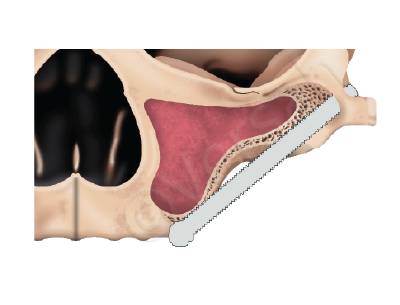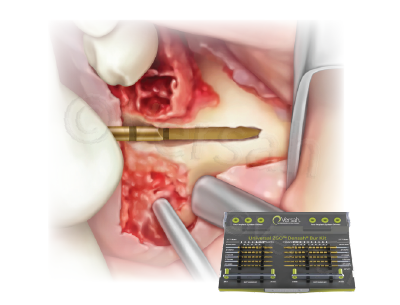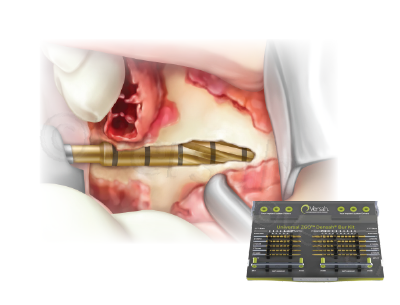Extra-Maxillary Extra Sinus Zygoma Protocol IV
Overview:
This ZGO protocol IV follows an extra-maxillary path. The maxilla and alveolar bone show extreme vertical and horizontal atrophy. The pathway is extra-maxillary with totally extra sinus path. The implant head is located buccal to the alveolar crest usually in a shallow “channel” osteotomy. Most of the zygomatic implant body has an extra sinus/extra-maxillary path. The coronal part of the zygomatic implant is extra-maxillary usually in a “channel” osteotomy whereas the apical part of the implant is surrounded by bone in a “tunnel” osteotomy in the zygomatic bone. The zygomatic implant contacts bone in the zygomatic bone and part of the external lateral sinus wall.

Step 1:
Create the coronal “channel” osteotomy using the regular Universal Densah® Burs starting with the VT1525 (2.0) working up to VT3545 (4.0) in Cutting Mode CW at 800 - 1500 rpm with copious irrigation as a “side cutter” to create a channel osteotomy in the residual alveolar ridge and the lateral wall of the maxillary sinus. Once the osteotomy gets closer to the sinus membrane, switch to CCW (OD mode) to preserve the sinus membrane integrity while defining the channel osteotomy.

Step 2:
Using the appropriate length ZGO Densah® pilot drill (65mm or 90mm) depending on the patient’s anatomy and size in CW mode, follow the “channel” trajectory to enter the inferior aspect of the body of the zygoma in order to prepare a “tunnel” osteotomy of the appropriate length just perforating apically through the superior-lateral aspect of the body of the zygoma.

Step 3:
After the pilot channel osteotomy, depending on the patient’s anatomy and size, use the appropriate length (65 mm or 90 mm length) ZGO Densah® Burs, starting with ZGO Densah® Bur ZT1525, in CW cutting mode/CCW densifying mode as needed to widen the osteotomy in a consecutive increasing order to achieve the desired osteotomy diameter and length depending on the zygomatic implant diameter and length to be placed. When getting close to the sinus membrane, drilling direction is changed to CCW in order to preserve the sinus membrane integrity.

Step 4:
The zygoma hardness and implant diameter will determine the final ZGO Densah® Bur diameter ie: ZT2030, ZT2535, or ZT3040. The ZGO Densah® Burs best to be utilized CCW/ CW as needed based on bone density at 800-1500rpm with copious irrigation.
1: Clockwise (CW) cutting mode for denser bone.
2: Counterclockwise (CCW) densifying mode for softer bone
3: A combination of CW & CCW using the Densify- Preserve after Cut (DAC) protocol for intermediate bone hardness.
Zygoma bone hardness and implant diameter will determine the final ZGO Densah® Bur diameter.

Step 5:
The zygomatic implant is then placed. The implant head sits on the buccal of the alveolar crest. The middle part of the implant body does not touch the most concave part of the anterior maxillary wall. In this extra-maxillary extra sinus path contacts bone at:
1: The buccal outer aspect of the crest
2: The zygomatic bone apically


Case courtesey of Dr. Costa Nicolopoulos
Data on file, visit versah.com/our-science/ for Zygomatic Implant studies
Clinician judgement and experience should be applied in conjunction with this clinical practice suggestive use protocol.
10531 REV04 11/2023


